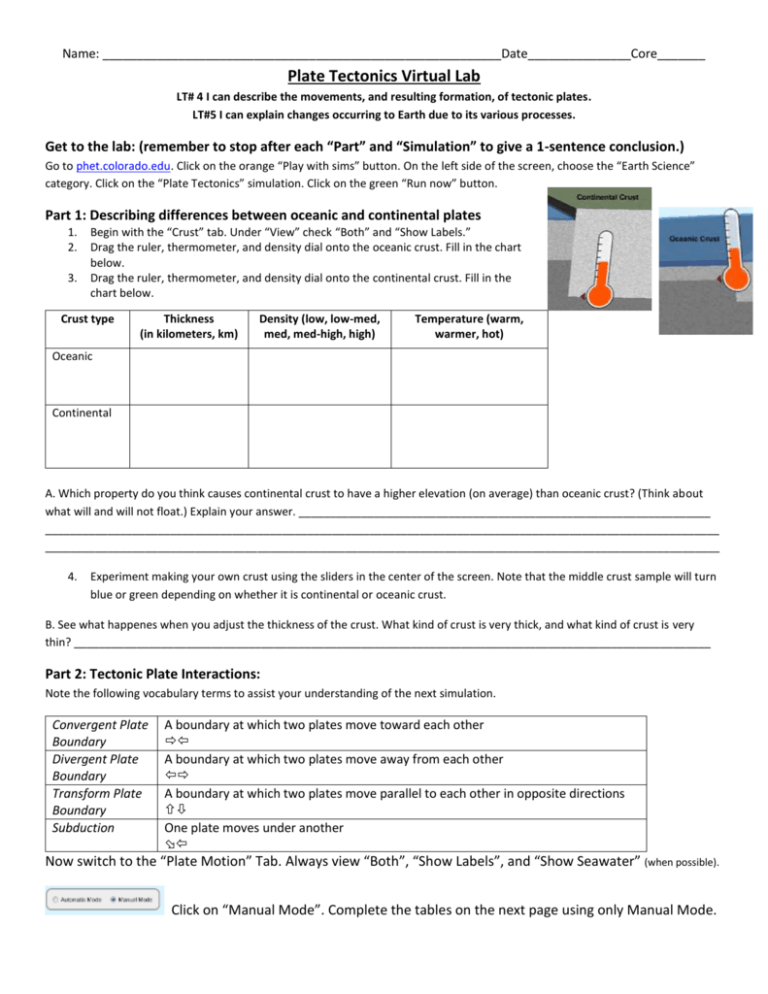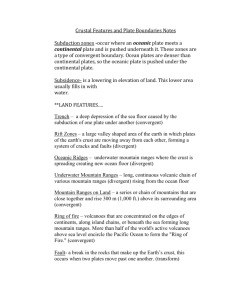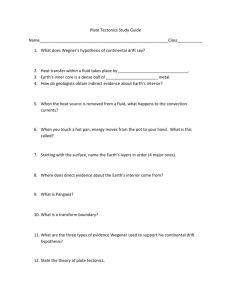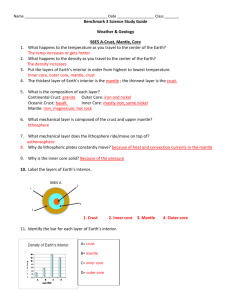Plate Tectonics Virtual Lab
advertisement

Name: __________________________________________________________Date_______________Core_______ Plate Tectonics Virtual Lab LT# 4 I can describe the movements, and resulting formation, of tectonic plates. LT#5 I can explain changes occurring to Earth due to its various processes. Get to the lab: (remember to stop after each “Part” and “Simulation” to give a 1-sentence conclusion.) Go to phet.colorado.edu. Click on the orange “Play with sims” button. On the left side of the screen, choose the “Earth Science” category. Click on the “Plate Tectonics” simulation. Click on the green “Run now” button. Part 1: Describing differences between oceanic and continental plates 1. 2. 3. Begin with the “Crust” tab. Under “View” check “Both” and “Show Labels.” Drag the ruler, thermometer, and density dial onto the oceanic crust. Fill in the chart below. Drag the ruler, thermometer, and density dial onto the continental crust. Fill in the chart below. Crust type Thickness (in kilometers, km) Density (low, low-med, med, med-high, high) Temperature (warm, warmer, hot) Oceanic Continental A. Which property do you think causes continental crust to have a higher elevation (on average) than oceanic crust? (Think about what will and will not float.) Explain your answer. __________________________________________________________________ ____________________________________________________________________________________________________________ ____________________________________________________________________________________________________________ 4. Experiment making your own crust using the sliders in the center of the screen. Note that the middle crust sample will turn blue or green depending on whether it is continental or oceanic crust. B. See what happenes when you adjust the thickness of the crust. What kind of crust is very thick, and what kind of crust is very thin? ______________________________________________________________________________________________________ Part 2: Tectonic Plate Interactions: Note the following vocabulary terms to assist your understanding of the next simulation. Convergent Plate Boundary Divergent Plate Boundary Transform Plate Boundary Subduction A boundary at which two plates move toward each other A boundary at which two plates move away from each other A boundary at which two plates move parallel to each other in opposite directions One plate moves under another Now switch to the “Plate Motion” Tab. Always view “Both”, “Show Labels”, and “Show Seawater” (when possible). Click on “Manual Mode”. Complete the tables on the next page using only Manual Mode. *Note: To see the same action happen again click “Rewind”, to change the plates completely click “New Crust”. Simulation 1: Drag 1 oceanic crust (either young or old) & 1 continental crust onto the screen. Drag the plate in the direction of the GREEN arrow. Type of Boundary? What is the effect/outcome of this plate movement? Convergent Divergent Transform Which plate subducts beneath the other? Why do you think that is? Sketch a time series of this process with at least three diagrams. Label the crust and show the direction of motion. 10 million years 30 million years 50 million years Simulation 2: Drag 2 old oceanic crusts onto the screen. Drag the plate in the direction of the RED arrow. Type of Boundary? What is the effect/outcome of this plate movement? Convergent Divergent Transform Where does the “New crust” come from? Simulation 2 depicts sea-floor spread. Sketch a time series of this process with at least three diagrams. Label the crust and show the direction of motion. 8 million years 20 million years 35 million years Simulation 3: Drag 2 continental crusts onto the screen. Drag the plate in the direction of the GREEN arrow. Type of Boundary What is the effect/outcome of this plate movement? Convergent Divergent Transform In this simulation, why does neither plate subduct beneath the other? Sketch a time series of this process with at least three diagrams. Label the crust and show the direction of motion. 5 million years 20 million years 35 million years Part 3: Exploration 1. Click on “Automatic Mode”. Experiment and find two additional plate interactions not yet described in this scenario. Complete the table below. Type of Crust Type of Boundary Sketch what it looks like Resulting Features PART 1: Oceanic and Continental plates are different in a few ways such as their thickness, densities, and temperatures. PART 2: Plate Boundaries are very important because this is where the action occurs, and plates cause changes. SIMULATION 1: Oceanic and Continental crusts are usually convergent, where the oceanic crust subducts beneath the continental and volcanoes eventually emerge. SIMULATION 2: Oceanic crusts are usually divergent (or transform) boundaries where the plates move apart, magma rises to the surface, and then cools under the water to create new sea-floor (sea-floor spreading) and mid-ocean ridges. SIMULATION 3: Continental crusts can move many different ways, but when they are convergent, they continue to push together, getting thicker, and create hills and mountain ranges. EXPLORATION: Transform boundaries can create very strong earthquakes, but have very little change in the land other than a small ridge on either side of the boundary.









